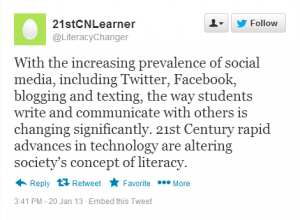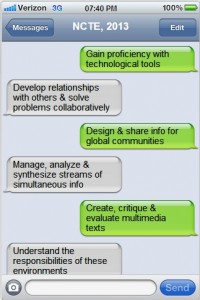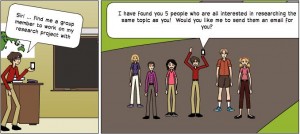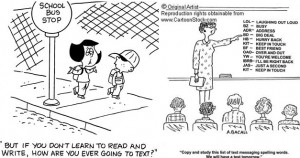
As our society continues to evolve, so must our understandings of what it means to be literate. The “nature of literacy, literacy learning, the look and feel of learning environments, the role of teachers, the nature of the learner and what and how students learn are being redefined” (NSW Dept. of Education, 2010) as the integration of technology into our lives becomes the norm.
Literacy
Just as communication is not limited to sentences and paragraphs on lined paper anymore, literacy is not limited to one’s ability to read and write. Literate students must now be able to understand that language is “a collection of flexible but variably potent symbols with a finite ability to carry meaning” (Heick, 2013).

Modern literacy is becoming focused on extracting meaning from, critically reflecting on and communicating through multiple sources. (Heick, 2013 & Selber, 2004) In today’s world, literacy gives an individual the ability to “effectively and creatively use and communicate information,” (Jones-Kavalier & Flannigan, 2006) as well as participate in new communities which are emerging within our networked society (Jenkins et al, 2006).
Our definition of literacy will continue to evolve (Gardner, 2008 & Leu et al., 2007). The NCTE (National Council of Teachers of English, 2013) has outlined six key abilities that 21st century readers and writers should have (see text message on right).
Social Media
The use of social media is one way in which students are achieving competency in these areas. Social media is defined as: forms of electronic communication (such as Web sites for social networking and microblogging) through which users create online communities to share information, ideas, personal messages, and other content (Merriam Webster, 2013). The idea of social software can be traced back to JCR Licklider’s ideas surrounding the use of networked computing to “connect people in order to boost their knowledge and their ability to learn” (Alexander, 2006).

Social software examples are widespread including weblogs, wikis, podcasts, videoblogs, Skype, Twitter, Facebook, YouTube etc. Their prevalence has even prompted the creation of the abbreviation YASN: Yet Another Social Network (Alexander, 2006). These interactive, community-focused tools foster the building of social networks where students can collaboratively create, discuss, share and modify content (Barnes, 2008).
A Shift … For Better or For Worse?

The infiltration of social media into our society has come with both positive and negative associations. Many argue that it has brought about the routine incorporation of acronyms (also referred to as texting language) into verbal and written speech. It isn’t uncommon to overhear students using the terms “BRB” or “LOL” in the hallways. However, a recent study conducted by PEW Internet and American Life Project identified that regardless of these terms frequent use, middle and high school students understood what kind of language was appropriate in what contexts (Lenhart, Smith, & Macgill, 2008) and were thus able to differentiate their vocabulary accordingly. Another criticism of social media is a decreased awareness of spelling and punctuation, specifically in regards to compound words. Digital tools often autocorrect misspelled words, provide correct spellings, or ignore misspellings altogether (ex/ news paper instead of newspaper) causing students to be unaware of their errors. On the other hand, many believe that social media has triggered a positive shift in attitude towards language, making writing relevant to students’ lives and encouraging creativity, which can spill over into school writing (Baron, 2009). Additionally, social media allow students to feel less restricted as they are less focused on correctness and more on personal expression (Baron, 2009). Some researchers even go as far as to say that electronic writing forms actually require more “sophisticated skills of understanding” (Johnson-Eilola & Selber, 2009) and teach students to distinguish between the style of language that is appropriate various tasks.
Through this project, we explore the three main transformations in relation to literacy we see as a result of the use of social media. Our goal is to demonstrate that the use of social media for literacy learning promotes collaborative learning, increases students’ motivation to write and changes the meaning of what it is to be an author and an audience.